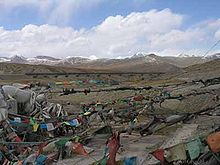Kunlun Mountains
| Kunlun Mountains | |
|---|---|
 View of Western Kunlun Shan from the Tibet-Xinjiang highway | |
| Highest point | |
| Peak | Liushi Shan |
| Elevation | 7,167 m (23,514 ft) |
| Geography | |
| Country | China |
| Region | Xinjiang, Qinghai, Tibet |
| Range coordinates | 36°N 84°E / 36°N 84°E |
| Borders on | Gobi Desert |
 | |
| Kunlun Mountains | |||||||
|---|---|---|---|---|---|---|---|
Tibetan ཁུ་ནུ་རི་རྒྱུད | | ||||||
| |||||||
| Uyghur name | |||||||
| Uyghur | قۇرۇم تاغ تىزمىسى | ||||||
The Kunlun Mountains[a] constitute one of the longest mountain chains in Asia, extending for more than 3,000 kilometres (1,900 mi). In the broadest sense, the chain forms the northern edge of the Tibetan Plateau south of the Tarim Basin. Located in Western China, the Kunlun Mountains have been known as the "Forefather of Mountains" in China.[1][2]
The exact definition of the Kunlun Mountains varies over time. Older sources used Kunlun to mean the mountain belt that runs across the center of China,
Extent


From the

The highest mountain of the Kunlun Mountains is the
The mountain range formed at the northern edges of the
The range has very few roads and in its 3,000 km length is crossed by only two. In the west, Highway 219 traverses the range en route from Yecheng, Xinjiang to Lhatse, Tibet. Further east, Highway 109 crosses between Lhasa and Golmud.
Kunlun Volcanic Group
Over 70
Mythology

Legendary and mystical mountains are a long-standing aspect of Chinese civilization. Kunlun is originally the name of a mythical mountain believed to be a
Kunlun is a semi-mythical region not far from the source of the Yellow River.[7] The Kunlun Mountains entered Chinese ideology during the Warring States period (475–221 BCE), and have become closely integrated into Chinese culture.[8]
In the Book of Mountains and Seas, the Kunlun Mountains are mentioned:
- 崑崙之丘,是實惟帝下之都,神陸吾司之。
Which means "The hill of Kunlun, which is the capital of the emperor, and the god of the land."
- "originates in the western plateau, and its magical and magnificent stories spread to the east, and then follow the vast and boundless sea. The combination of these natural conditions has formed the Penglai mythology system in the coastal areas of Yan, Wu, Qi, and Yue."[9]
In mythology, Kunlun Mountain is the birthplace and ancestral place of the Chinese nation. In mythology, Kunlun Mountain is the center of heaven and earth. It goes up to the sky and is the staircase to the sky. The "Kunlun Mythology" system takes Kunlun Mountain as an iconic place, and mainly focuses on the myths and stories of related characters such as the Yellow Emperor and the
Mao Dun pointed out:
- "The primitive people imagined that the gods lived in a group, and they also imagined that the gods lived on the extremely high mountains, so the highest mountain in the territory became the residence of the gods in mythology. The mystical idea of this is what happened. The Chinese myth is equivalent to that of Kunlun.
According to legend,
See also
Notes
- ^
- simplified Chinese: 昆仑山; traditional Chinese: 崑崙山; pinyin: Kūnlún Shān, pronounced [kʰu̯ə́nlu̯ə̌n ʂán]
- Uyghur: قۇرۇم تاغ تىزمىسى or قۇرۇم تاغ تىزمىسى Qurum Tagh
- Mongolian: [хөндлөн уул]
References
- ^ "Kunlun Mountains". Retrieved April 1, 2024.
- ^ "Kunlun Mountain Range - A Forever Legend" (PDF). Retrieved April 1, 2024.
- OCLC 2281016.
- ^ National Geographic Atlas of China, 2008
- ^ "Kunlun Mountains". Encyclopædia Britannica. Retrieved 2009-11-19.
- ^ "Kunlun Volcanic Group". Global Volcanism Program. Smithsonian Institution. Retrieved 2014-03-15.
- ^ 贾海建. 神怪小说与山岳信仰关系研究 《中央民族大学》 2011 年博士论文.
- S2CID 244133983.
- ^ 许洋洋. 中国神话的地域文化透视.
Further reading
- Munro-Hay, Stuart Aksum. Edinburgh: University Press. 1991. ISBN 0-7486-0106-6.
External links
- Kropotkin, Peter Alexeivitch; Bealby, John Thomas (1911). . Encyclopædia Britannica. Vol. 15 (11th ed.). pp. 938–941.
